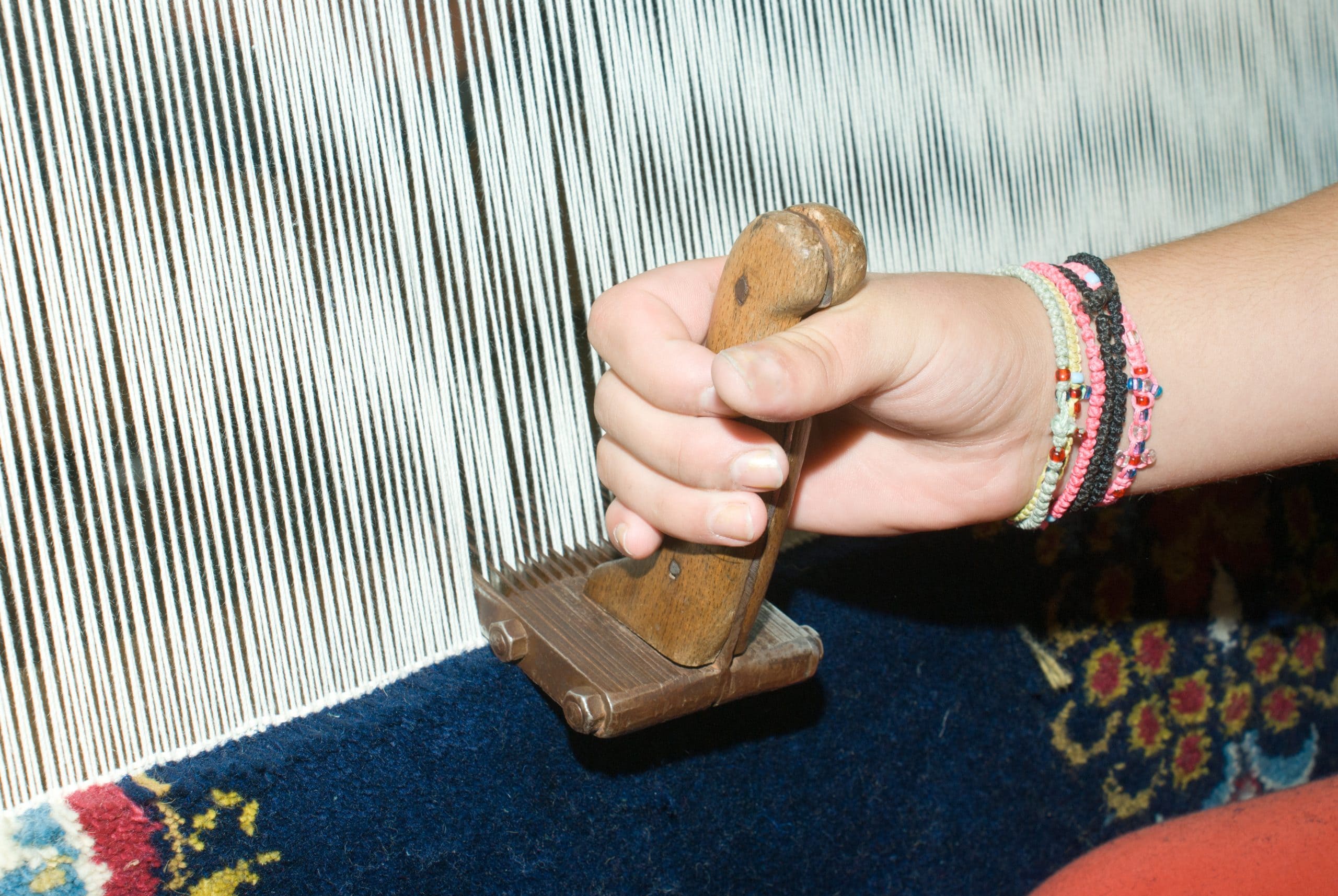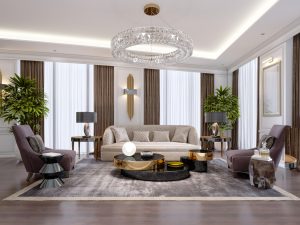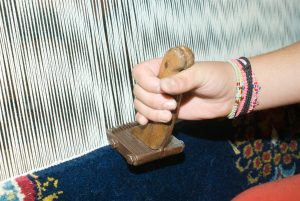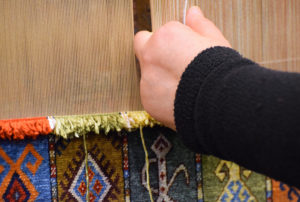The history of Pakistani Handmade Rugs
The beauty and grace of Pakistani rugs are well-known. These rugs look fantastic in any room of the house. These rugs are handcrafted with the highest quality materials and one-of-a-kind patterns and designs to make a stunning statement in any living space. Pakistani carpets are developed by experienced designers who utilize natural vegetable dyes to bring diverse colours to the fibre—designed and produced in Pakistan. When selecting a Pakistani rug for your home, you have various styles, colours, designs, and materials to pick. Rug-knots has the best selection of vintage Pakistani rugs to make your home look sophisticated and attractive.
Pakistani rugs have been handcrafted for ages to meet the desires of cultural admirers by artisans who have inherited the technique of carpet weaving from their forefathers. Yes, children are frequently taught the traditional method of weaving carpets and rugs through training under the supervision of their elders. As a result, the cultural themes and conventional designs that dominate the face of Pakistani rugs UK are vintage, having been passed down through generations and kept by Pakistan’s expert weavers.
Here’s an exciting fact Pakistani rugs are not only captivatingly magnificent, with eye-catching colour schemes and designs telling stories, but they are also extremely long-lasting and robust. The Pakistani rug you will buy can be repurposed to decorate your grandchild’s living room. Because they’re usually dyed with natural pigments, the colours of these carpets are very sharp and never fade; the wool remains soft and maintains radiate an ambience of their majesty for years. Why do people from all over the world look for Pakistani rugs for sale in each carpet store? Let me explain because these rugs come in various styles, colours, forms, and sizes. Essentially, a Pakistani carpet will always be the enchanting blend!
Pakistani rugs are a long-term investment you can walk on. They’re fantastic and last a long time, prized as beautiful heritage pieces. These rugs are now handcrafted to perfection using imported New Zealand yarns. Despite their superior quality and longevity, their initial pricing is affordable.
It gets better Pakistani rugs wholesale also come in numerous sizes, including runner rugs, small/large area rugs, contemporary rugs, and antique rugs. Instantly adding a contemporary touch to your living space. These carpets are traditionally constructed and solely by the hands of skilled designers who have prospered in this sector for decades, despite being mass-produced.
History:
You might be wondering from where and when carpet weaving was introduced in Pakistan? So here’s the kicker weaving invented in the Pakistani region when few other civilizations practised it. Archaeological sites at Moenjodaro and Harappa, two ancient settlements in the Indus Valley civilization, revealed that the residents used spindles to spin a range of weaving materials. According to some historians, the Indus Valley culture was the first to use woven textiles.
With the arrival of the earliest Muslim conquerors, the Turkic Ghaznavids, and Afghan Ghaurids, carpet weaving may have been introduced into the area of modern-day Pakistan as early as the eleventh century. Can trace it back to the beginning of the Mughal Dynasty in the early sixteenth century, when Babur, Timur’s last successor, expanded his control from Kabul, Afghanistan, to Dhaka, Bangladesh, and established the Mughal Empire.
Local artisans borrowed Persian techniques and designs with the assistance of the Mughals. When the South Asian Subcontinent was split into two states, most professional Muslim carpet weavers from India went to Pakistan and found work in major cities like Lahore and Karachi. Lahore carpets with the themes and artistic styles prevalent in Mughal architecture were used in rugs woven in Punjab.
Hand-knotted rug production is currently Pakistan’s second-largest cottage and small business. The artisans may create any style of carpet employing various motifs such as Gul, medallions, paisleys (Botehs), traceries, and geometric designs in different combinations. While red carpets are the most common in Pakistani rugs, they are also available in different colours. Bokhara rugs are available in various solid colours, ranging from red to gold to brilliant iridescent tints. Some Pakistani carpets can also combine colours; for example, Beljik rugs include multiple black, blue, and deep red shades.
These handcrafted carpets come in various patterns—rug patterns in Pakistan span from geometric designs in Bokhara to floral prints. You can also find Medallions on Pakistani rugs, such as those from Peshawar. Carpets from Pakistan are one of the country’s most famous exports. They’re long-lasting, sturdy, and have design patterns that turn heads.
Types of Pakistani rugs:
Pakistani carpets are traditional floor coverings created by hand in Pakistan. Pakistani designers and manufacturers created these. Pakistani rugs are known for their durability, endurance, and strength. The most affordable way to decorate your home! They’re crafted with high-quality materials and have a smooth, soft feel that adds a perfect touch of relaxation and warmth to your space!
Want to know the best part? Pakistani rugs are available in a wide range of styles, which, on the other hand, isn’t a laugh! Here is a list of several sorts! You can browse for Pakistani rugs online to choose the one that best suits your personality and complements your existing interior decor.
Pak Persian rugs:
Persian art is renowned for its creativity and ingenuity. As the name suggests, In Pak Persian rug pieces, Persian design patterns and weaving techniques are combined with Pakistan’s high-quality wool forming even more gorgeous handcrafted luxuriant patterns. In the past, these multicoloured rugs were considered a mark of riches. So let’s take a closer look.
Art was regarded as the most lovely item on the Indian subcontinent during the golden era of the Mughals. Every piece of art had a strong Persian influence. Its calligraphy, architecture, and the groundbreaking technique of carpet weaving spread across the Indian subcontinent. Pakistan, which is recognized for its beautiful, high-quality rugs, combined the art of Persian rugs with their masterpieces to create Pak Persian rugs. Because of the design that supports them, these area rugs are commonly referred to as Oriental carpets. The craft of carpet weaving originated in Persia, but it has since found a home in several cultures.
Beautiful designs are created using high-quality, organically coloured wool in Pak Persian art pieces. As more colours are added to the palette by local artisans, the colouring of these rugs is also changed. Muted pastel accents are applied to these colours and patterns by using the typical rich and saturated tones. Either they are becoming a less expensive version of these carpets, or they are no longer preferred due to the availability of new raw machined components. Persian rugs coupled with Pakistani rugs are a great match that is becoming increasingly rare as contemporary artists lack the skills to make such works of art.
Persian rugs are made using a unique weaving technique. Each thread is knotted to create a more intricate pattern. These area rugs have a soft top pile print on the backside. New wool is used to make these rugs, giving them a high quality and refinement level. The dyes used in these rugs are generally natural and organic. The synthetic colours used in Pak Persian rugs are not original.
What’s more, you know what? One Pak Persian handmade rug can take up to 12-14 months to complete.
Pak Persian rugs can be overlayed over basic background rugs. A strong coloured plain rug may bring grandeur to your home when coupled with a floral Pak Persian rug. Pak Persian carpets are also suitable for use as a prayer rug because they closely resemble Persian rugs. A Pak Persian rug with deep, rich colouration and a traditional diamond logo is ideal for a royal look. With its brilliant colours and sleek lushness, a piece like our red Pak Persian rug with tangerine and black colours may add nobility. Warm tones with accents of gold will provide comfort and chic to any living space for a more alluring look with a touch of elegance.
Pak Persian carpets provide everlasting richness and quality to complement and enrich any living area, whether you’re drawn to the delicate design or the unique cultural background.
Bokhara rugs:
Tekke-faced rugs are generally referred to as Bokhara. Tekke was a Central Asian tribe from the Bokhara region. Rows of Gul dominate the design, which is surrounded by geometric structures. The Tekke tribe has borrowed some design elements from the Salor tribe, who lived in the Bokhara region of Central Asia. According to some historians, the Tekke defeated the ancient Salor tribe and incorporated their designs. Rugs with “Bokhara” designs are being produced all over the world, including in Pakistan.
The Pakistani Bokhara describes modern Tekke-faced rugs made in Pakistan, among the most popular handmade rugs globally.Thanks to a combination of New Zealand worsted and native Pakistani wool on a cotton foundation, the Pakistani Bokhara has a particularly soft and silky, giving them that lush feel that heavy heap you will prefer.While this gives it a stronger and more durable texture, it also prevents more elaborate designs from being created on the rug. However, the soft, palatable feel heavy that you can think compensates for this. The length of the rise varies depending on how the carpet was clipped. The bundle is often purposefully left substantially longer, known as “double pile,” resulting in increased thickness and depth at the expense of pattern clarity.
Bokhara rugs come in various patterns and styles that will make your home feel magnificent and royal. The best part about these rugs is that they are inexpensive and constructed of high-quality materials and fabrics. Pakistani rugs Bokhara for sale are typically acquired by Pakistanis in the United Kingdom. If you are one of them, rug-knots is a great place to go for a low-cost, high-quality experience.
Moreover, Pakistani rugs Bokhara, particularly those from Pakistan, can come in various colours, including tan, orange, light and dark blue, green, blue, and even gold. When it comes to beauty, Bokhara rugs are among the most stunning. Natural dyes derived from local items and tree bark are responsible for the spectacular rainbow of hues evoked.
A deep shade of burgundy coupled with a recurring design of octagonal motifs is an example of the typical Bokhara rug. Dark blue, black, or brown designs with ivory undertones are prevalent. However, the patterns’ forms and tones differ from tribe to tribe.
Popular for their vintage style, handmade properties, red tint, wool material, heavy heap attractive colours, durability, and affordability. They are rooted in the history of Pakistan, to fit in very well with any décor scheme, making your room appear more cultured.
Beljik rugs:
Beljik rugs are the type of Pakistani rugs, borrowing patterns and styles from the older traditions of Afghanistan. Hand-knotted carpets are currently created in Pakistan by Afghan refugees, making carpets one of the country’s most popular export items. The weavers may create any style of carpet employing various motifs such as medallions, paisleys, traceries, and geometric designs in different combinations.
The Beljik is known for its striking colour, which ranges from rich reds to blues to blacks. These carpets are widely regarded as the best tribal style rugs. They’re constructed out of highly spun wool and knotted into beautiful geometric patterns with ornate borders.
Trust me, you haven’t seen this before. The Beljik rug is a mesmerizing piece of art that is another sort of ethnic mosaic with beautiful patterns woven by Pakistani craftsmen. Because the wool used in these carpets is exclusively obtained from the sheep’s belly, they require many sheep. So, if you’re looking for something unique and high-quality, a Pakistani Beljik rug made of beautifully spun wool and hand-knotted over 16 to 18 months could suit your décor needs—Beljiks intricate geometric patterns, marking the elegance of your space!
Chobi rugs:
Chobi rugs are particularly popular these days since their patterns and motifs blend in so well with the décor in many modern homes. These area rugs will well with a wide range of home decor styles. Because of the neutral colours utilized in these rugs, representing many of the colours found in nature and natural materials like stones and various types of wood and ceramic, we’ve seen them used in homes with wood or tile floors with spectacular results. The Chobi rug type has a remarkable capacity to complement and tie together a room with all of these elements.
Chobi was invented in Lahore, and weaving centres are established along the Pakistan-Afghanistan border. Rugman invested a substantial amount of money in the region to establish workshops to weave Chobi rugs. Western carpet exporters and department stores collaborated with Eastern producers to create new, modified oriental styles to fulfil demand.
So let’s get down to business. Turkoman weavers use natural colours and Ghazni handspun wool to create the rugs in our Chobi line, also known as Peshawar carpets. The patterns are based on antique motifs, with the highest-quality Chobi rugs. Chobi rugs are known for having abrash (or various shades of the same hue) running through the pile, as well as muted colours, both of which are due to the use of natural dyes and handspun wool. Chobi rugs are frequently available in a wide range of sizes and colours.
Chobi can work in any environment. It doesn’t matter if it’s traditional or contemporary. Imagine this Floral patterns and neutral to mild red tones dominate Chobi carpets, warm up a modern area. A Chobi rug is also be used to contrast with the colour of the walls or furnishings. If you have light-coloured walls, you can use gentle reds or greens to create a dramatic contrast in the room. Chobi carpets can also be used to give the place an antique feel. Another option is to layer your space. When you have a vast room and not a lot of furniture, this works best. Mixing a solid carpet with a patterned rug like a Chobi is the easiest method to deal with layering.
Even with the constraints of colours and textures, you can consider your taste. Consider the sights, sounds, and memories that come to mind. Perhaps you have a rug under your computer desk that looks like your grandfather’s teacup. Every carpet is hand-woven with love, affection, and care, intending to merge your aesthetic sense with characters!
Pak Gabbeh rugs:
Gabbeh carpets are a type of Persian carpet that has been around for a long time. A Gabbeh is a hand-woven pile rug of medium size (90 x 150 cm, three by 5 ft, or more), traditionally used as a sleeping rug, with an abstract design that focuses on open fields of colour and geometric playfulness. Kurdish, Luri and Qashqai people live in the Zagros Mountains of Iran, and this sort of rug is popular among them. Women are usually the ones who make the Gabbeh.
A Pak Gabbeh has modern contemporary patterns and is extremely close to a Persian Gabbeh. Senneh and Ghiordes knots are commonly used while weaving with handspun wool and vegetables.
Pak Gabbeh rugs are rough and primitive, with simple designs and only a few decoratives, typically rectangular shapes that resemble mostly animals. Pak Gabbeh carpets generally are brightly coloured, such as yellow and red. Although Gabbeh designs use enormous fields of solid colour, the hue fluctuates across the rug, giving the appearance of several coloured zones.
Gabbehs are composed of pure, handspun wool yarn with natural plant dyes. A Gabbeh is one of the less expensive Persian carpet variants due to its relative simplicity of production (less accurate pattern, lower knots per square centimetre, etc.).
Gabbeh floor coverings are found in the southwest of Iran, and its weaving sets them apart from the others. Gabbeh translates to “rough or raw” in Farsi, exactly how they weave. In their designs, they emphasize stripes and geometric motifs. The diversity of six or seven vibrant colours, though, is what sets them apart. These rugs make fantastic area rugs and bring a room to life due to their strength and vibrant colours. They’ll look great in a traditional or antique-styled home. Gabbeh carpets can be employed in old, rustic, diversified, and contemporary settings.
The main distinguishing element of handcrafted Gabbeh rugs is their peculiar design pattern, which differs significantly from other tribal rugs. Gabbeh rugs, in contrast to most traditional carpets, do not have a symmetrical design pattern. They’re known for their animal iconography and emblems, which look more appealing by using bright colours. The symbols are asymmetrically distributed throughout the rug’s surface, producing an unconventional aesthetic with a vintage sense,So give the floors a life of splash of colour.
Baluchi rugs:
Baluch or Balochi carpets are traditional tribal rugs created in the Baluchistan region on Iran’s eastern border, western Pakistan, and southern Afghanistan. Because they were originally manufactured for use in nomadic tribes inside tribal tents, Balochi rugs frequently feature geometric motifs and tribal designs that are highly variable, consisting of repeated motifs, diagonally placed across the field. Balochi carpets can be utilized as entry rugs or in smaller spaces,and they look well in both traditional and minimalistic settings.
Baluchi rugs frequently have lengthy collars at both ends that are ornamented with stripes and brocading bands. Older carpets have a dark colour scheme with traces of white, consisting of reds, browns, and blues. Various tan hues, either camel hair or material dyed to seem like it, are also used in several pieces. Baluchi rugs are normally made entirely of wool, but they may also contain goat and camel hair, cotton for whites, and a few silk knots. In most cases, the knotting is asymmetrical.
Here’s an interesting fact prayer rugs are the most widespread, having a simple rectangular arch-head design on one end (to indicate the direction of the holy city Mecca). The leaves and stems of a highly stylized tree usually occupy the field of these prayer carpets, and miniature geometric plants occur in the spandrels.
The use of dark hues is common in Baluchi rugs. Dark brown, dark blue, and an almost black navy blue often contrasting with white, ivory, yellow or orange patterns are common colours in Baluchi carpets. Colours like purplish-brown are employed in older Baluch rugs. The colour of the rug can also be affected by the type of wool used. As a result, a Baluch rug made of natural undyed camel wool can be unusually light. Onion or henna dye is also be blamed for the light brown tint.
Baloch rugs design, pattern, motif, and colour set them apart from other carpets. Baluch carpets are smaller and use a different sort of dye than other rugs. 3 x 5, 4 x 6, and 5 x 7 are common sizes. Rectangular carpets are the most popular shape among Baluchi rugs. Other shapes are occasionally generated. Baluchi carpets are woven differently than other huge rugs. The loom in huge rugs is upright and standing. Due to the modest size of Baluchi carpets, the loom is usually horizontal and put on the ground.
Baluchi carpets are soft and supple yet incredibly durable, and they have a distinct sense of age and history. Because of their tribal appeal, they are in high demand in the West. Baluch rugs are limited due to their tribal origins and outstanding value for money!
Jaldar rugs:
Jaldar is a Pakistani design inspired by ancient Sarooq and Yamud patterns, which are made largely in Afghanistan and Pakistan and exported and marketed worldwide. Jaldar rugs have symmetrical knotting (single knot), with wool piles and typically silk accents. Jaldar, like most Pakistani carpets, features cotton bases. Because of their comparable construction and material composition to Pakistani Bokharas, Jaldars are sometimes referred to as Bokharas.
Because both rugs have symmetrical patterns, many people confuse Jaldar rugs with traditional Bokhara rugs. The motifs on both rug patterns are arranged in rows across the rug surface. The only distinction is that the ‘elephant foot’ motif found in Bokhara rugs is absent from Jaldar rugs. In reality, the Gul designs on Jaldar rugs are more angular, diamond form.
Let’s jump right in handmade carpets are works of art, and like any work of art, their creation necessitates a tremendous deal of labour, hard work, and time. Multiple weavers create a single handmade rug. They work every day, tying each knot with their hands for 5-6 months, sometimes even longer depending on the size of the rug, with no room for error.
Handmade Jaldar carpets are created using the symmetrical knotting technique. Jaldar carpets are produced using ancient Turkish knotting techniques. Additionally to other variables, such as the use of high-quality wool, this knotting style was a vital contributor to the durability and longevity of Jaldar rugs.
Let us tell you about another wonderful aspect of handmade Jaldar rugs while we’re talking about the quality of wool used. Even today, the wool used in their production is not only of the highest quality but is also dyed entirely with natural dyes! No synthetic wool is used in these rugs, making them an excellent eco-friendly alternative to machine-produced carpets composed of wool coloured with synthetic colours. Another significant advantage of purchasing a naturally coloured wool rug is that the colours of these rugs never bleed and rarely fade.
To sum up Jaldar rugs are constructed of wool and cotton, just like many other Persian and Pakistani carpets. A handcrafted Jaldar rug’s basis or foundation is constructed of high-quality cotton, while the rug pile is made of soft, rich wool. Jaldar rugs are typically constructed of brushed or processed wool that has the appearance of silk strands. Its use in rug making gives antiques a silky appearance and a splendidly charming appearance.
So, here’s the deal to last your vintage Jaldar rug long, place it in a spot that receives less foot traffic!
Dhurrie rugs:
Dhurrie rug is ideal for anyone with distinct tastes. But what is a dhurrie rug, exactly? What exactly is it constructed? You’ve come to the right place if you’re not familiar with dhurrie carpets.
The Dhurries contains sophisticated flatweave carpets created with pure wool in strict adherence to local craftsmen’ traditions. Collectors covet antique Dhurries for their rich texture and gentle colours, which are expertly replicated in these magnificent carpets. Classic geometric designs are equally at home in casual, modern, and classic settings because of their organic variations in pattern and tone. Although these rugs are now found throughout the world, they were once only found in India, Burma, Pakistan, and Afghanistan.
The carpets have a very tight weave and are flat woven on a horizontal loom. Dhurrie area rugs are extremely durable, thanks to the tight weave, and can withstand moderate to high foot traffic. Most dhurrie rugs are also reversible, allowing you to switch them out regularly—this assists in extending the life of your carpets and rugs. Traditionally, rugs were made of wool or cotton, but they are now manufactured of a wide variety of materials. Some dhurries are composed of jute and silk, in addition to cotton and wool.
Wool dhurrie area rugs are a great choice for high-traffic areas since they feel great underfoot. Cotton rugs are softer than wool carpets and can be used in areas with mild foot traffic. Synthetic materials are usually more fade and moisture resistant than natural materials.
Dhurrie rugs, just like centuries before, can be used in a variety of ways in a modern residence. While the styles and patterns may differ, the sizes are quite consistent. Dhurrie carpets are 12″ x12″ at their smallest size. These rugs are too little to be used as a rug and should instead be used as a tablecloth. The maximum size available is 20’x20′.
Consider chevron stripes or a geometric lattice motif for a contemporary look. Floral and stripe patterns are classic and timeless, while paisley and tribal patterns add a touch of bohemian to space. Take into account the other elements of your design while choosing patterns. Large-scale patterned rugs are mixed with small-scale prints and vice versa. These are the right floor covering for your hallway, living room, bedroom, dining room.
Think about this for a moment dhurrie flatweave carpets are a popular designer option for almost any space. Dhurrie rugs are a natural choice in casual settings due to their robust and resilient flatweave. Furthermore, because today’s decor is more adaptable, these flat-woven carpets are being used in more formal settings. Dhurrie rugs and flatweave rugs have long been popular due to their adaptability and transitional appeal. The introduction of these rugs will enhance more contemporary flat weave rug designs, the aesthetic of your space.
“You Only Expect Greatness” Buy Now








